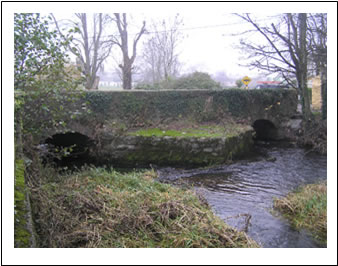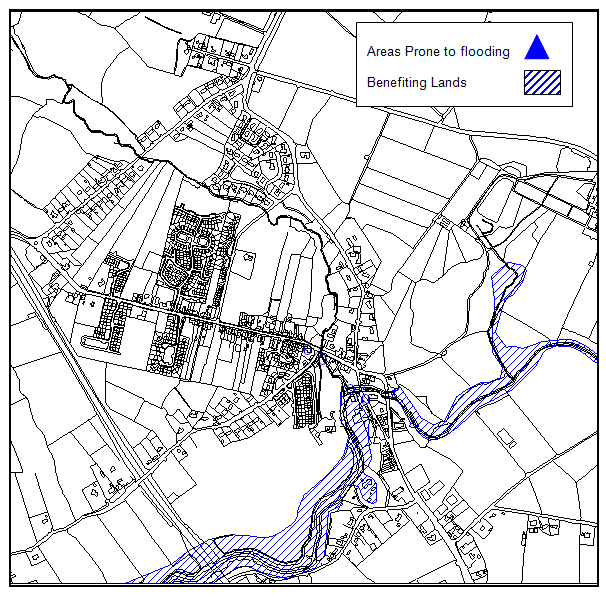2.2 Infrastructure
2.2.1 Water supply
Piltown is served by the combined Mooncoin and Fiddown-Piltown water supply scheme. At present, water supply volumes serving Fiddown-Piltown are inadequate to cater for further development. Kilkenny County Council is currently in the process of upgrading and augmenting the existing Mooncoin Regional Water Supply Scheme which will have a positive impact on the Piltown/Piltown water supply scheme. The upgrade of the Mooncoin Regional Water Supply scheme is set to take place over 3 phases of works. Currently works are being undertaken for phase 1. The works as part of phase 1 will relieve pressure on parts of the existing water supply scheme serving Piltown-Piltown and allow for small amounts of further development, and is due to be complete in the third quarter of 2010. Further upgrading of the water supply will be dependent on phases 2-3 of the Mooncoin Regional Water Supply scheme, a date has not been finalised as yet for these works to commence.
The Fiddown- Piltown water supply scheme has been included for allocation of funding in the Water Services Investment Program for phases 1 & 2 of the upgrading works; these works are necessary to accommodate the natural increase and growth of the village as proposed in this plan.
Water Quality Analyses over the years show that water quality in the area is good. Water quality is monitored on a daily basis by the Council’s staff, in accordance with the HSE requirements to ensure that water quality remains high. The lime content of the water is suitable for consumption, and whilst it solidifies when heated, cannot be readily removed from the water supply.
A Water Conservation Project is underway across the county at present. The first stage of this project divided the water supply schemes into different zones and installed meters. The second stage is active leakage control, which includes detecting and repairing leaks.
Policy:
- IN1 – To conserve valuable water supplies by eliminating leakages and through raising public awareness of the need for water conservation.
- IN2 – To preserve free from development the way leaves of all public water mains.
Objective – IN3:
To provide water in sufficient quantity and quality to serve the needs of the existing and future population and commercial development, for all lands zoned for development in this plan, as resources and finances permit.
2.2.2 Waste Water Treatment
Piltown is served by a sewerage scheme with secondary treatment, which was constructed in 1985. This has a design Population Equivalent of 1500, and is currently operating with a population equivalent of 3000 and therefore does not have capacity to cater for future demand.
Piltown has been included in the Water Services Investment Programme for upgrading of the wastewater treatment plant to accommodate existig and future development as outlined in this plan, a timeframe has not been set for the delivery of the upgrade which will also be dependent on funding from Kilkenny County Council.
Policy:
- IN4 – Significant additional development shall not be permitted to the wastewater treatment until such time as the scheme is upgraded to adequate capacity and treatment levels.
- IN5 – To preserve free from development the way leaves of all public sewers.
Objective – IN6:
To maintain and improve wastewater treatment services and to upgrade the treatment system to cater for the future growth of the town as resources and finance permit.
2.2.3 Surface Water Drainage & Flood Risk Management
2.2.3.1 Surface Water Drainage
The County Development Plan requires a separation of the surface water system from the foul drainage system. Surface water run-off shall be restricted to pre-development levels and consideration will be given to the use of Sustainable Drainage Systems (SuDS). The County Development Plan also requires that new development should not itself be subject to an inappropriate risk of flooding nor should it cause or exacerbate such a risk at other locations.
There is no existing system specifically designed for stormwater disposal in Piltown. Individual developments facilitated under the guidance of this plan shall be obliged, in all cases where surface water drainage measures are required, to provide a surface water drainage system separated from the foul drainage system. In this regard Kilkenny County Council will consider all stormwater drainage proposals consistent with SuDS (Sustainable Drainage Systems).
In the design of surface water systems, regard shall be had to the Kilkenny County Development Plan 2008 – 2014 and the Greater Dublin Regional Code of Practice for Drainage Works and associated GDSDS technical documents.
New development should adopt water saving measures throughout; such measures could include – water butts to collect rainwater, low flush and dual flush toilets, low water use appliances, rainwater harvesting and grey-water recycling.
Policy:
IN7 – To seek separate stormwater systems for all developments, and to consider all proposals consistent with SuDS (Sustainable Drainage Systems).
IN8 – Require that new development should not itself be subject to an in appropriate risk of flooding nor should it cause or exacerbate such a risk at other locations.
2.2.3.2 Flood Risk Management
In line with The Planning System and Flood Risk Management Guidelines for Planning Authorities (2009) a Strategic Environmental Assessment Screening has been carried out for this plan.
The Office of Public Works (OPW) has identified the levels of existing flood risk in and around the River Suir and its tributaries. In co-operation with various Local Authorities within its catchment area, the OPW are conducting a ‘Catchment Flood Risk Assessment and Management (CFRAM) Study’ of the entire catchment area, including lands at Piltown.
Figure 4 shows lands identified as ‘Benefiting Lands’ on the OPW’s website as part of the National Flood Hazard Mapping; these are lands that might benefit from the implementation of Arterial (Major) Drainage Schemes (under the Arterial Drainage Act 1945) and indicating areas of land subject to flooding or poor drainage.
This gives an approximate estimation of the extent of the floodplain at Piltown. The lands thus identified have been zoned as ‘Open Space’ under the Zoning and Land Use Map, or have been zoned for Phase 2 development (i.e. not within the life of this plan), or are part of an existing use. Some of these lands are within the area identified as a candidate Special Area of Conservation under the EU Habitats Directive. In this regard, it is a policy of the LAP to keep this area free from all inappropriate development.
In compliance with the Guidelines, there is no potential flood risk identified within areas planned for growth, and the plan therefore accords with the guidelines’ sequential approach in avoiding developing lands that may be vulnerable to flooding.
Flooding of the Pil River occurs a number of times per year, as recorded on the Office of Public Works (OPW) National Flood Maps and from information gathered from local residents during public consultation. The worst areas affected being the Main street, Creamery Road and the Tybroughney road; residents in Tybroughney are cut off from the village during flood events. A number of residential properties have also been affected by the flooding.
The ‘Preliminary Report Pil River Drainage Study’ carried out by Kilkenny County Council in December 2002 states:
The main problematic flooding area is located where the two tributaries of the Pil meet. This meeting point is located in the centre of Piltown village, just south of the Main Street and to the west of the Creamery Road. The Pil River is tidal and during periods of sustainable rainfall and high tides, the Pil River will burst its banks and flood the Main Street and Creamery Road areas of Piltown village and farmland south of the village to the River Suir, a distance of approximately 2.5km. A problem that is further aggravated by southerly winds.
Having conducted interviews with local residents and through our own records, taking a fiver year period from 1998-2002. The Pil River on average bursts its banks ten times per year.
Flooding appears to be caused by a number of contributing factors – the tidal nature of the Pil River, heavy rainfall, wind direction, siliting of the river chanel, blocking of the chanel by debri and the restriction of water flow by a services pipe in the eye of the bridge.
Some works have been carried out to clear the river channel of the Pil River, however flooding remains a significant concern in the town.
Figure 4 – Areas identified as Benefiting Lands & Lands Prone to Flooding in Piltown
Source: OPW flood mapping & consultation with local residents
Policy:
IN9 To require new development to demonstrate that it will not have a negative impact on the Pil River floodplains and to ensure that the banks of the Pil River will be maintained free from inappropriate development, and that its culverting or realignment will be discouraged.
IN10 To require all significant developments impacting on flood risk areas to provide a Flood Impact Assessment, to identify potential loss of flood plain storage and how it would be offset
Objective:
IN11 To investigate in conjunction with the OPW the causes of flooding in Piltown and to seek the necessary funding for the remedial defence works required to prevent its reoccurrence in the future.
IN12 To remove the obsolete watermain under the bridge to improve river flow at this location.
2.2.4 Waste Management
The Joint Waste Management Plan for the South East sets out the policy for Kilkenny and the south east region for the plan period 2006-2011.
Waste collection was privatised by the Council in the 1990’s and both recyclables and residual waste are now collected in Piltown by private contractors once weekly. There is a bottle bank in Piltown at present, where glass bottles and drinks cans are recycled, this is located near the Garda Station and was awarded ‘Best Presented Bring Bank 2007’ in the South East. One day per week a service is provided in Newrath for the recycling of cardboard, plastic and papers for householders in areas without a waste collection service.
The South East Regional Waste Management Plan has an objective to provide a recycling centre for the south of the county. A site has been identified in Granny, however this is dependent on adequate available funding. This will be a one-stop-shop centre for all recyclables including paper, cardboard, plastic, steel food cans etc.
It is noted from public consultations that litter remains a concern in the town. Kilkenny County Council carries out street cleaning in Piltown, which will continue on a monthly basis. The Council’s Environmental Awareness Officer provides regular dissemination of information through group meetings, leaflets and other promotional materials, and any community can access these services. These services will continue to improve the level of environmental awareness throughout the county and encourage recycling and promotion of more sustainable practices.
Policy:
IN13 – To continue to work with, and encourage the prevention, minimisation, re-use, recycling and safe disposal of waste in line with the South East Regional Waste Management Plan.
2.2.5 Telecommunications
Telecommunications have become centrally important to the prospects of any local economy. Broadband is available in the Piltown area through mobile, satellite and Digital Subscriber Line (DSL) providers.
Policy:
IN14 – To support and encourage the provision of the necessary telecommunications for the existing and future development of Piltown.
IN15 – To ensure development proposals include the provision of ducting for fibre based data services and in particular broadband services, as appropriate.
Questions to consider for Infrastructure
Do you agree with this approach, if so, why?
Do you disagree with this approach, if so, why?
What would you like to change?
Are there any other issues that you feel should be considered?
Please submit your answers to these questions or add your comments using the comment box below.
_______________________________________
Please also indicate below whether you are making a comment or whether you are making a formal submission to the plan.


